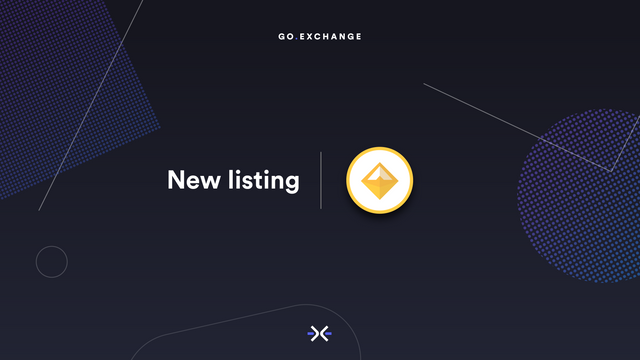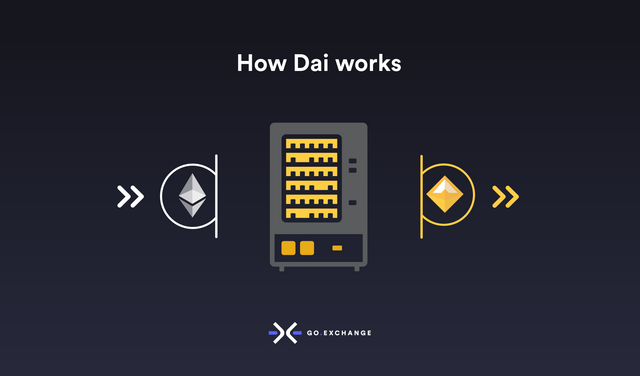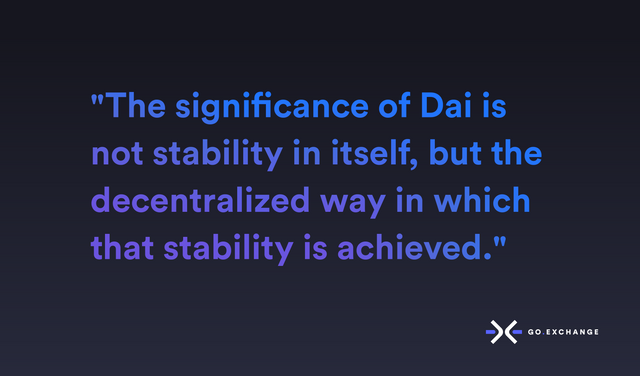Dai: The Decentralized Stablecoin

We are excited to announce that starting now, Dai trading is supported on GO.Exchange! As big believers in Dai, we wanted to share our thoughts with our community about the significance of Dai and the influential role it plays in the growing decentralized movement. We will cover:
- What Is Dai and How Does It Work?
- Why Does Dai Matter?
- How Can I Interact with Dai?
What Is Dai and How Does It Work?
In this blog post, we want to focus on why Dai matters rather than on how Dai works, so this section will be a summary and will not go into deep detail. If you would like to read a more in depth writeup on how Dai works, we recommend reading this comprehensive post by MakerDAO.
As everyone in the blockchain space knows, most cryptocurrencies are highly volatile. This can make using crypto for payments such as monthly rent a difficult process. Because of the issues with volatility, stablecoins have become increasingly popular and important. Stablecoins are cryptocurrencies that are pegged to a fiat currency (generally the US Dollar) while retaining the properties of cryptocurrencies, such as being able to move around easily via blockchain transactions. Prior to Dai, every stablecoin was managed in a centralized way by ensuring that for every stablecoin in circulation, there is $1 of real USD sitting in a bank to back it.
Dai, on the other hand, is an asset-backed, decentralized stablecoin spearheaded by MakerDAO. Unlike other stablecoins, there is no centralized entity that manages the reserves of Dai’s circulating supply. Instead, there are a set of rules that govern how Dai is created and destroyed. To generate Dai, a user creates a Collateralized Debt Position CDP which locks the user’s ETH as collateral. The amount of Dai which can be generated from a CDP is equivalent to a maximum of ⅔ of the value of ETH. For example, with $300 worth of ETH, a user may generate up to $200 in Dai. The user must maintain a collateral:Dai ratio of 1.5 times ($300/$200), otherwise the CDP will be liquidated.

o unlock their collateral (ETH), the user must pay back the Dai created, plus a stability fee. The Dai received to unlock a user’s ETH is then destroyed (Dai cannot exist in circulation without ETH backing it as collateral).
The stability fee is a tool of Dai’s decentralized monetary policy. When the price of Dai drops below $1, increasing the stability fee makes creating Dai more expensive, which should lower the supply of Dai, which drives up the price. When the price of Dai exceeds $1, decreasing the stability fee makes creating Dai less expensive, which should increase the supply of Dai, which lowers price. (The stability fee is not centrally decided, but decided by the votes of people holding Maker’s governance token, MKR. For simplicity, we will not go further into this topic, but if you are interested, you can learn more in this three-part series on Maker's Governance and Risk Framework.)
Through this system, Dai has become a decentralized and independent stablecoin, benefitting the broader crypto ecosystem.
Why Does Dai Matter?
As mentioned in the previous section, Dai brings a decentralized and trustless method for accessing and maintaining stability in price. The significance of Dai is not stability in itself, but the decentralized way in which that stability is achieved. To understand why this matters, it is helpful to take a step back to look at the values of the blockchain ecosystem as a whole.

The birth of Bitcoin brought the concept of decentralization into the mainstream dialogue by demonstrating to people all around the world that value could indeed be stored and transferred in a trustless way over the Bitcoin blockchain. Following Bitcoin, Ethereum showed the world that computation and logic could be done in a decentralized way over the Ethereum blockchain.
The Bitcoin and Ethereum blockchains are prime examples of what we view as public goods that are maintained by decentralized communities of miners, entrepreneurs, community members, technologists, researchers, investors, users, and more. These decentralized chains are especially helpful for individuals who may not have access to personal banking, or may live in countries with limited financial access to the rest of the world. These public goods may also be helpful for individuals who simply prefer to keep their wealth in a system which is not dictated by any government or corporation but is rather dictated by the rules of the chain’s protocol, which are transparent to all. In this way, these chains provide an independent alternative to the traditional and centralized institutions that currently exist.
Until December 2017, when Dai was first released into the wild, there was no way to achieve price stability in a decentralized manner. The stablecoins that came before Dai, while very useful, achieved stability in a way that did not mirror the decentralized nature of the blockchain industry. This is not to say that these stablecoins don’t have their place in the crypto ecosystem — in fact, centralized models generally allow for quicker action, scale, and user adoption. However, with centralization comes tradeoffs.
One of the main drawbacks of centralized stablecoins is counterparty risk, which is the risk that a central entity can default on its contractual obligations. This risk can be seen most prominently with Tether (USDT), which has long been subject to controversy regarding whether or not USDT was fully backed 1 to 1 by USD. Earlier in 2019, a statement from an attorney representing Tether confirmed this uncertainty by claiming that USDT is only backed by approximately 74% of cash and cash equivalents. One of the reasons that USDT is underfunded is due to the fact that Tether/Bitfinex’s bank, Cryptocapital, was unable to return funds that Bitfinex deposited to them, stating that they could not because the funds were frozen by various governments. If USDT is not properly collateralized at the 1 to 1 ratio, the value of USDT could theoretically drop to $0.74 or lower, hurting USDT holders and traders and creating confusion in the broader crypto markets as a whole.
In comparison, because Dai is created through a decentralized process of auditable smart contracts, it is transparent at all times, minimizing counterparty risk. There is no bank holding Dai’s collateral and no government that could freeze that collateral. This is why we view Dai as a public good, much like Bitcoin and Ethereum, because it provides an independent alternative for achieving price stability. It is only natural that a community and industry that is fully dependent on decentralization would value a protocol that brings stability in just that way.
How Can I Interact with Dai?
As Dai has grown more popular, an increasing amount of services now allow for usage of Dai. For example, some of the places people can interact with Dai are through:
- creating, managing, and obtaining baskets of tokenized assets through Set;
- lending and borrowing on Dharma or Compound Finance or Nuo;
- decentralized margin trading on dYdX;
- getting exposure to the S&P 500 through UMA;
- borrowing against ETH to mint Dai through opening a CDP, allowing the user to maintain a long position on ETH while avoiding a taxable event.
In addition to the above, the most exciting way to interact with Dai, known as Multi-Collateral Dai MCD, will be arriving later in 2019. Currently, ETH is the only accepted collateral for Dai. However, through MCD, tokens other than ETH will be able to be used as collateral to open CDPs and generate Dai. Through the diversification of assets that MCD allows, Dai will no longer be dependent solely on ETH, which should lead to a more stable Dai. Perhaps most interestingly, MCD will incentivize users to lock up other tokens aside from ETH, which benefits these tokens by adding new utility to them as well as helping to decrease the token velocity of these newly eligible tokens.
The ecosystem incorporating Dai is growing rapidly and the trustless nature of Dai allows for more and more decentralized projects to access stability in a decentralized way. In fact, this growing ecosystem creates additional resilience for Dai. Through MCD, Dai will become less dependent on ETH and allows more access to creating Dai. Additionally, because there is an increasing number of places that is affected by the price of Dai, there is an increasing number of arbitrage opportunities that arise when the price of Dai diverges from its $1 USD peg. With the larger amounts of arbitrage opportunities available, the stability of Dai grows stronger day by day. For example, Max Bronstein, a business development manager at Dharma Labs, describes the way in which Dharma helps with Dai’s stability: “As Dai slips under a dollar, trading at like $0.97, people can actually go buy Dai and lend it on Dharma for 11 percent annual [interest] rate… With Dharma, we’re actually helping push the [Dai] price back up to a dollar. We’re helping to create [demand] there and filling this gap. Right now Dai holders really don’t have a way to earn interest.”
We hope that by providing Dai on GO.Exchange, we can help to increase the avenues in which a user can acquire and interact with Dai and help drive even further adoption. We are excited to be able to support Dai in our own way.
Conclusion
As you can probably tell, we are big fans of Dai and are excited to list Dai on GO.Exchange. Dai is much more than just a stablecoin — Dai is a public good that gives people around the world another option to access stability through crypto.
To celebrate this listing, we will be giving away 5,000 Dai! The first 100 users to trade $250 or more on any DAI based pair over the next 14 days will be rewarded with 50 Dai. To learn more about this giveaway, please read here.
We want to hear from you! Share your thoughts on Dai with us! Why do you like Dai? What Dai crosses do you want to see next? Come let us know on Telegram, Reddit, Twitter, wherever. All our contact links are below.
Thank you as always to our valued community. We hope you enjoy trading Dai. We also still have some OMG left for new signups, so take advantage of that too while it’s still here!
Feel free to follow our progress through these channels: